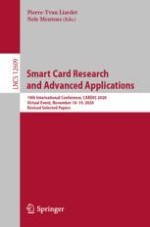2021 | Book
Smart Card Research and Advanced Applications
19th International Conference, CARDIS 2020, Virtual Event, November 18–19, 2020, Revised Selected Papers
Editors: Dr. Pierre-Yvan Liardet, Nele Mentens
Publisher: Springer International Publishing
Book Series : Lecture Notes in Computer Science
